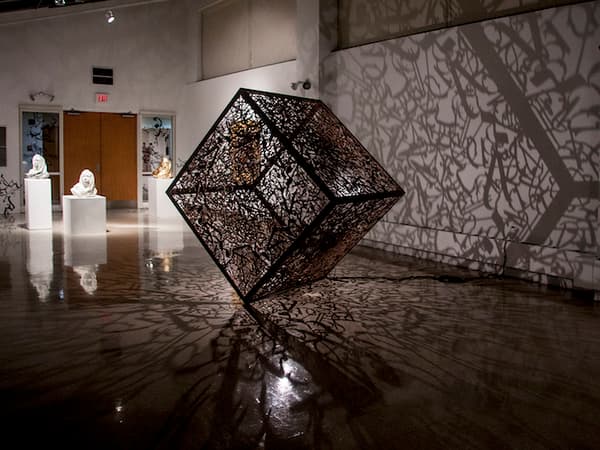Contemporary art has long moved beyond galleries and museums, becoming an essential part of everyday visual environments. In interior design, it plays not only a decorative role but also influences the perception of space, emotions, and mood. Paintings, sculptures, and installations bring character, emphasis, and individuality to any room. More and more interior designers in the Czech Republic are using art objects as tools for expressing ideas and creating a unique atmosphere. This article explores how art has become a central element of design and why its presence in a space matters.
The New Role of Art in Interior Design
Contemporary art is no longer limited to collections and museum exhibitions. Today, it is actively integrated into residential and commercial spaces, becoming a powerful tool for setting ambiance. Paintings, sculptures, and installations have become integral to design decisions, and artists increasingly collaborate with architects and decorators. Art in interior design not only highlights the style of a room but also sets the tone, draws attention to specific zones, and even changes how space is visually perceived.
In the Czech Republic, this trend is particularly visible in cafes, boutiques, coworking spaces, and modern offices, where unconventional art objects are used as a means of communication with visitors. An abstract painting in a waiting area or a minimalist sculpture in a lobby is no longer just decoration—it defines identity and creates an emotional connection.
Art and Space: A Symbiosis of Form and Meaning
The choice of artwork depends not only on aesthetic preferences but also on the functional purpose of the space. For example, large-format paintings with soft color transitions are popular in residential interiors, as they create a sense of calm. In public spaces, designers often prefer bold and provocative works that spark conversation and hold attention.
Installations are especially effective. These large-scale pieces alter the very structure of a space, engaging the viewer in dialogue. Through the use of light, reflective surfaces, and unconventional materials, installations can visually enlarge a room, guide movement, or create an illusion of depth. Such art often becomes the focal point, turning an ordinary room into a dynamic art environment.
Sculptures, meanwhile, add depth and substance to an interior. They can range from classical styles to avant-garde forms that play with scale and texture. Incorporating sculptures into interior design requires balance: an object that’s too massive may overwhelm the space, whereas a well-chosen accent can underscore the architectural logic of the room.
Current Trends in Art and Design
Modern artists are increasingly working with mixed media, creating works that defy traditional categorization. This flexibility makes them particularly attractive to interior designers seeking uniqueness and expressiveness. In 2025 interiors, there is a clear trend toward eco-consciousness—paintings on recycled materials, sculptures made of wood, metal, and glass, and installations that respond to light and movement.
So-called digital art is also gaining popularity. Its elements are integrated into smart homes and creative offices. These include media screens with ever-changing visuals, generative animations, and interactive art objects that respond to voice or movement. In homes and public spaces across the Czech Republic, hybrid forms of art and technology are increasingly present, reflecting a desire to blend visual experience with modern innovation.
The same trend can be seen in the field of online entertainment. For example, visiting the site novecasino.net, one can find platforms featuring digital casinos that use artistic elements in their interface designs: animations, 3D effects, and stylized illustrations. All of this affects how space is perceived even in a virtual environment, where users are literally “surrounded” by digital design. Thus, visual art transcends the physical world, continuing to influence emotional states and human behavior.
Paintings as a Tool for Personal Expression
One of the most accessible and flexible ways to transform an interior remains the use of paintings. Today, the market offers works by renowned artists as well as custom prints and reproductions. Minimalism, abstraction, and neo-expressionism are particularly popular. These genres integrate seamlessly into interiors of various styles—from Scandinavian to industrial.
A painting in an interior always tells a story. It can evoke travel memories, reflect the owner’s views, or serve as a mirror to their inner world. In the Czech Republic, there is growing interest in the works of local artists, whose creations often reference Bohemian culture, traditions, and nature. This not only supports local art but also brings unique cultural identity into the space.
Art as an Investment in Quality of Life
Incorporating art into interior design is not just a trend—it is a conscious choice in favor of aesthetics and inner harmony. Contemporary art has the ability to create an emotional environment, provide therapeutic benefits, reduce stress, and stimulate creative thinking. This is especially relevant in today’s urbanized, information-heavy world, where people increasingly seek calm and visual grounding.
As the online sphere occupies more and more areas of our lives—from work to entertainment—live art serves as a reminder of materiality and the importance of tactile and visual contact. It makes space feel “real,” helps us pause, and allows us to experience the moment. Therefore, art today is not a luxury but a way to improve quality of life, enhance spatial identity, and discover a new way of seeing the world.
Contemporary art is the language through which design speaks to a person. And if the interior is a story, then art makes it truly memorable.
